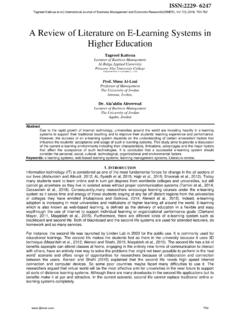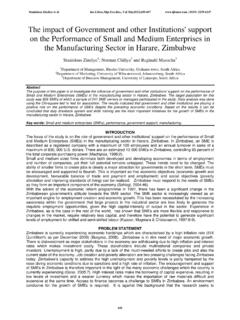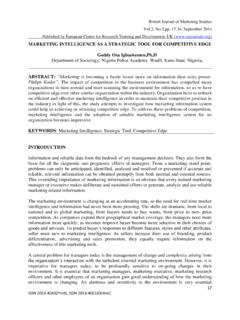Transcription of A Comparative Analysis of Strategies and Business ... - IJBMER
1 A Comparative Analysis of Strategies and Business Models of Nike, Inc. and Adidas Group with special reference to competitive advantage in the context of a Dynamic and competitive Environment Hussain A. Ali Mahdi1, Mohammed Abbas2, Taher Ilyas Mazar3 1,2,3 MBA Student, University of Bahrain, Kingdom of Bahrain Dr. Shaju George4 4 Assistant Professor, Department of Management & Marketing College of Business Administration University of Bahrain Kingdom of Bahrain Abstract: Strategy is about the most crucial and key issues for the future of organizations. Strategy is also important to explore several strategic options, investigating each one carefully before making strategic choices.
2 The study incorporates a rigorous and systematic effort to uncover the Strategies and its impact on the company s performance by analysing case studies, articles and the annual report of Nike Inc. and Adidas Inc. The study attempts to find out the relevance of the Strategies adopted by these companies, which are globally successful athletic apparel companies in the context of Bahrain. The findings of the study highlight Nike s Strategies which focus on innovation and emphasis on its research and development department, provision of premium pricing for its customers, broad differentiation strategy, market Segmentation Strategy and Closed-Loop strategy.
3 The Adidas Strategies focus on the broad differentiation, innovation, trying to produce new products, services and processes in order to cope up with the competition. It embraces a multi-brand strategy, emphasis on expanding activities in the emerging markets, continuously improving infrastructure, processes and systems, foster a culture of challenging convention and embracing change, foster a corporate culture of performance, passion, integrity and diversity. These Strategies coupled with its resources and unique capabilities form the basis of sustainable competitive advantage for both the companies.
4 Key words: Strategy, Sustainable competitive advantage , Product Portfolio. INTRODUCTION: The strategy is a path towards achieving the optimum goals of individuals, groups and organizations. In addition, it leads to a best use of companies' available resources and it also guides the company to stay in a Business successfully and continuous improvements for its processes. The definition of strategy could be differ from one author to another, but the most common definition is that the strategy is long term plans and approaches towards the intended visions and objectives. It is a general framework that specified the organizations' plans, policies and approaches to meets its objectives, goals and end results.
5 The way an organization used to shape its Strategies could be differentiate from other organizations in order to make its products unique and remarkable. Globally, companies formulate their Strategies based on their visions and reaching the satisfaction of customer's needs, requirements and expectations. Subsequently, they use those Strategies as a baseline to compare their actual performance with planned ones, to evaluate the end results and ensuring the continuing organizational excellence. There are many kinds of Strategies that are pursued by the companies; Such as cost leadership, differentiation and the focus Strategies (Porter, 1985), services Strategies , growth Strategies .
6 Based on the goals, the companies form those Strategies and they rank them upon the priorities. It is more than important for any organization to put Strategies and not any Strategies ; the correct Strategies which are formulated after a long time of studying and after numerous number of brainstorming among the top management members. Therefore, those Strategies then to be implemented by converting the organization's plans and policies into real actions through the best use of available resources such as: human resources, budgets and technological advance; in order to enhance the organization's performance, productivity and sustainability.
7 Hussain A. Ali Mahdi et al | International Journal of Business Management and Economic Research( IJBMER ), Vol 6(3),2015, The organization's continuous evaluation and controlling of its Strategies is an aid to make ensure that the goals and objectives have been met and the appropriate Strategies have been selected. Therefore, those successful Strategies should be documented and retained to use them in the future's goals. But, since the goals haven't been met so the current Strategies should be revised and corrected by the top management. LITERATURE REVIEW Definition of Strategy: Strategy has been studied for years by Business leaders and by Business theorists.
8 Yet, there is no definitive answer about what strategy really is. One reason for this is that people think about strategy in different ways. The strategy is a configuration and formation of available resources for an organization towards meeting the needs, requirements and expectations of markets and stakeholders. It is also a long run direction and scope of an organization that determines the visions and goals (Gerry Johnson & Kevan Scholes, 2008). In addition, it is a plan leads an organization towards competitive advantage . Further, it is a pattern in actions over time and it is a position that reflects decisions to offer the organization's products or services in particular markets (Henry Mintzberg, 1994).
9 In some cases, the strategy is the pattern of decisions in a company that determines and reveals its objectives, purposes and goals. Also, strategy produces the principal policies and plans for achieving those goals. It defines the range of Business the company is to pursue, the kind of economic and human organization intend to be (Kenneth Andrews, 1980). Strategy is about decisions taken by top management to reach a company's stability and sustainability. Moreover, it refers to basic directional decisions, that is, to purposes and missions. Strategy consists of the important actions necessary to realize these directions, and it is also the end that the company wants to reach after selecting the proper directions (George Steiner, 1979).
10 In reality, not all Business decisions are belong the strategic circle; the strategic decisions are those which doing something differently from competitors and that difference make a sustainable advantage . Even, the activities that are used to increase productivity are not strategic since they can be easily imitated by others (M. E. Porter, 1996) Generally, Strategy is a framework that provides guidance for actions to be taken and, at the same time, is shaped by the actions taken, and it has nine possible driving forces: Products offered, Market needs, Technology, Production capability, Method of sale, Method of distribution, Natural resources, Size/growth, Return/profit (Benjamin Tregoe & John Zimmerman, 1980).













